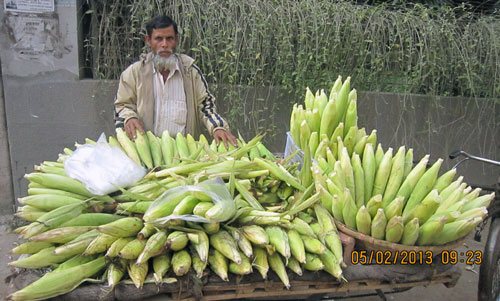 While maize is an important cereal crop in Bangladesh – third only to rice and wheat in terms of cultivated area and second to rice in terms of production – it has not been widely used for human consumption. To discuss filling this gap, CIMMYT-Bangladesh and Bangladesh Agricultural Research Institute (BARI) organized an event on ‘Prospect and opportunity of promoting maize as human food in Bangladesh’ with Natalia Palacios, CIMMYT maize nutrition quality specialist, on 3 February 2013. The event was chaired by Rafiqul Islam Mondal, BARI director general, and facilitated by Mokhlesur Rahman, director of training and communication, and Bhagya Rani Banik, BARI leader of hybrid maize program. It was attended by almost 80 participants from Bangladesh Agricultural Research Council (BARC), BARI, Department of Agriculture and Extension, Bangladesh Rehabilitation Assistance Committee, NGOs working with maize, and CIMMYT.
While maize is an important cereal crop in Bangladesh – third only to rice and wheat in terms of cultivated area and second to rice in terms of production – it has not been widely used for human consumption. To discuss filling this gap, CIMMYT-Bangladesh and Bangladesh Agricultural Research Institute (BARI) organized an event on ‘Prospect and opportunity of promoting maize as human food in Bangladesh’ with Natalia Palacios, CIMMYT maize nutrition quality specialist, on 3 February 2013. The event was chaired by Rafiqul Islam Mondal, BARI director general, and facilitated by Mokhlesur Rahman, director of training and communication, and Bhagya Rani Banik, BARI leader of hybrid maize program. It was attended by almost 80 participants from Bangladesh Agricultural Research Council (BARC), BARI, Department of Agriculture and Extension, Bangladesh Rehabilitation Assistance Committee, NGOs working with maize, and CIMMYT.
Maize is an attractive crop for Bangladeshi farmers for several reasons, the demand from producers of poultry and fish feed who purchase approximately 90% of maize produced in the country in particular. Only the remaining portion is used for human consumption. Furthermore, maize has at least double the yield potential of rice and wheat and thus provides greater returns for lower production costs. Maize productivity in Bangladesh is the highest in South Asia (7 t/ha), 99% of the total maize growing area has favorable production environment. Annual demand for maize is slightly over two million tons with a total annual deficit of one million tons. However, the incidence of bird flu in 2008 drastically reduced the area under maize cultivation in 2009, as there was no significant demand for maize. This indicated that maize production in Bangladesh is highly dependent on the poultry industry; it also signifies that sustainable maize production in Bangladesh cannot be achieved without diversifying its uses, including promoting maize for human consumption, the topic of the event.
T.P. Tiwari, CIMMYT-Bangladesh cropping systems agronomist, focused on the necessary changes, including moving away from crops requiring a high amount of water, particularly during winter season, as depletion of water table has resulted in higher production costs, which makes such crops less profitable for farmers. Maize, on the other hand, requires less irrigation. It also has an enormous potential to expand as winter cereal with significantly lower production costs, which is why it is often considered the ‘future crop of Bangladesh.’ If promoted as human food, maize can be the best option for addressing food security. This is no news, as similar views were highlighted in a 2011 report ‘Agricultural Research Vision 2030 and beyond: Research Priorities in Bangladesh Agriculture.’ Tiwari then stressed the urgent need for proper orientation and mentoring regarding maize as human food. Palacios explained the prospects and opportunities to promote maize for human consumption and highlighted that Mexico alone produces around 600 maize food items, 300 of which are consumed regularly. She also emphasized quality protein and biofortified maize in regards to fighting the problem of malnutrition. In the end of her presentation, she thanked BARI and CIMMYT-Bangladesh for the opportunity to share her experiences and thoughts. Following Palacios, the event was concluded by Mondal’s closing remarks. He mentioned multiple potential uses of maize that could satisfy farmers’ needs, such as food, feed, firewood, or fodder. He further stressed the need for practical training on how to make maize food items at local level.
 Climate adaptation and mitigation
Climate adaptation and mitigation